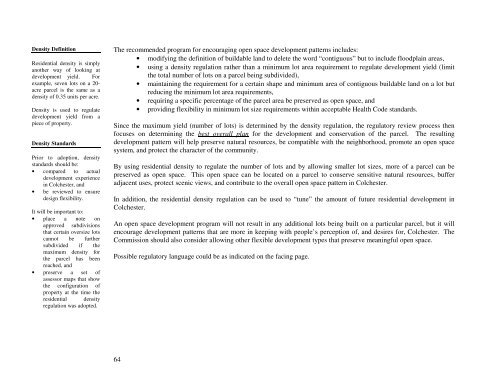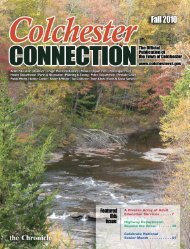2 - Town of Colchester
2 - Town of Colchester
2 - Town of Colchester
- No tags were found...
You also want an ePaper? Increase the reach of your titles
YUMPU automatically turns print PDFs into web optimized ePapers that Google loves.
Density Definition<br />
Residential density is simply<br />
another way <strong>of</strong> looking at<br />
development yield. For<br />
example, seven lots on a 20-<br />
acre parcel is the same as a<br />
density <strong>of</strong> 0.35 units per acre.<br />
Density is used to regulate<br />
development yield from a<br />
piece <strong>of</strong> property.<br />
Density Standards<br />
Prior to adoption, density<br />
standards should be:<br />
• compared to actual<br />
development experience<br />
in <strong>Colchester</strong>, and<br />
• be reviewed to ensure<br />
design flexibility.<br />
It will be important to:<br />
• place a note on<br />
approved subdivisions<br />
that certain oversize lots<br />
cannot be further<br />
subdivided if the<br />
maximum density for<br />
the parcel has been<br />
reached, and<br />
• preserve a set <strong>of</strong><br />
assessor maps that show<br />
the configuration <strong>of</strong><br />
property at the time the<br />
residential density<br />
regulation was adopted.<br />
The recommended program for encouraging open space development patterns includes:<br />
• modifying the definition <strong>of</strong> buildable land to delete the word “contiguous” but to include floodplain areas,<br />
• using a density regulation rather than a minimum lot area requirement to regulate development yield (limit<br />
the total number <strong>of</strong> lots on a parcel being subdivided),<br />
• maintaining the requirement for a certain shape and minimum area <strong>of</strong> contiguous buildable land on a lot but<br />
reducing the minimum lot area requirements,<br />
• requiring a specific percentage <strong>of</strong> the parcel area be preserved as open space, and<br />
• providing flexibility in minimum lot size requirements within acceptable Health Code standards.<br />
Since the maximum yield (number <strong>of</strong> lots) is determined by the density regulation, the regulatory review process then<br />
focuses on determining the best overall plan for the development and conservation <strong>of</strong> the parcel. The resulting<br />
development pattern will help preserve natural resources, be compatible with the neighborhood, promote an open space<br />
system, and protect the character <strong>of</strong> the community.<br />
By using residential density to regulate the number <strong>of</strong> lots and by allowing smaller lot sizes, more <strong>of</strong> a parcel can be<br />
preserved as open space. This open space can be located on a parcel to conserve sensitive natural resources, buffer<br />
adjacent uses, protect scenic views, and contribute to the overall open space pattern in <strong>Colchester</strong>.<br />
In addition, the residential density regulation can be used to “tune” the amount <strong>of</strong> future residential development in<br />
<strong>Colchester</strong>.<br />
An open space development program will not result in any additional lots being built on a particular parcel, but it will<br />
encourage development patterns that are more in keeping with people’s perception <strong>of</strong>, and desires for, <strong>Colchester</strong>. The<br />
Commission should also consider allowing other flexible development types that preserve meaningful open space.<br />
Possible regulatory language could be as indicated on the facing page.<br />
64







